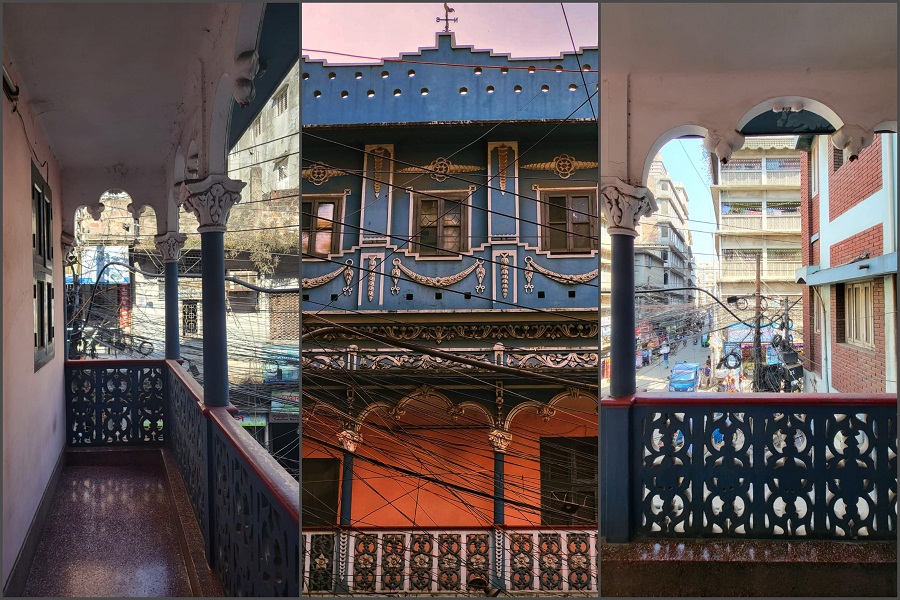
Published :
Updated :

When Anjun Dutta sang 'Koshbar oi neel deyaaler ghor', maybe he meant something like Bangshals's iconic house, standing at the eastern side of the Bangshal road. The house and the people of this residence have a deep-rooted link with the father of the nation, Bangabandhu Sheikh Mujibur Rahman. From the Second World War and the partition of 1947 to the liberation war, the house has witnessed some of the tragic events of history.
Origin
To some city dwellers or newcomers, the house may just be a blue-coloured old house, but locals called it Majju Bepari's house, The house of the leader, or just Fazlul Karim's house. Hazi Mazharul Haque, famously known as Majju Bepari (Majju businessman), built this house in the early 1930s. He was one of the sons of Hazi Osman Gani, a great landlord of Dhaka.

Hazi Mazharul Haque. Photo - Md. Imran
"Hazi Mazharul Haque had four sons; the eldest one was Fazlul Karim, who was a famous politician and one of the closest allies of Bangabandhu Sheikh Mujibur Rahman," said Mahbubur Rahman, the oldest resident of the house; Fazlul Karim was his paternal uncle. Since then, the house has a significance to the Dhaka people.
It is a three-story building standing in an area of three katha (more than 4000 sq feet). The blue-coloured building has a balcony on the first floor. The border of the windows is outlined with the geometrical design in white. The roof-rallying is curved and looks like a crown to a king. It was a common architectural design of the buildings of Bangshal from that era.
Historical events
"Most of the inner parts of the house was burnt into ashes," Mahbub Ur Rahman said, taking us into a flashback of the brutality of the Pakistani military in 1971.
Fazlul Karim's involvement with the Awami League made the house notable to the Pakistanis. The people were not present at the time of 'Operation Searchlight.'

Fazlul Karim with Bangabandhu Sheikh Mujibur Rahman
"Many of us went to the Kazi Alauddin Road beside Mayor Hanif's house, then moved to the Keraniganj. The Pak army even went to Keraniganj to kill our family members but we fled to another village. So the nine months of the liberation was a time of turmoil both for us and for the house," he said.
Political significance
Since the building has been standing on its ground for 9 decades, it has witnessed several turning points in history and played a significant role in shaping Bangladesh's political history.
"When Bangabandhu was murdered on the 15th of August, 1975, we saw an upright change in the scenario of the political events of Bangladesh. After that brutal murder, the ruling regime tried to sabotage the party, forcing them to stop political activities. In that crucial time, my uncle Fazlul Karim played the role of a leader and held the party allies together," said Mahbu Ur Rahman.
"This house was used as a hub where different significant political figures used to come and have meetings to discuss the plan of Awami League. Figures like Sher-e-Bangla A.K. Fazlul Huq, Hossain Shahid Suhrawardy, and Mayor Hanif visited the house quite often. Banga Bir Kader Siddiqui and the late Abdur Razzak used to sit with my uncle and discuss the roadmap. Fazlul Karim was then the cashier of Awami League." he further said.
Now
Dhaka has changed a lot over the years. The narrow road was only sometimes like this. If one had a walk of 30 minutes in the streets of old Dhaka, one would see many ruined houses; some are like palaces under which there are car repair shops, maybe the market of chilly-onions or carpet, leather, and rexine cloth just like the Fazlul Karim's house.
In the times of the developer's crusade, the blue-painted building is still on the crease of Old Dhaka, batting in its 90s.
Mahmub Ur Rahman doesn't want to sell it or demolish it. He said, "I am the third generation living in this house, I have renovated it, especially the rooms but not the outer wall. We kept it as it was in the beginning. So much history is associated with this house, we don't want to demolish the building. Even the govt has ordered not to demolish it and give it to the developers."
mohd.imranasifkhan@gmail.com


 For all latest news, follow The Financial Express Google News channel.
For all latest news, follow The Financial Express Google News channel.